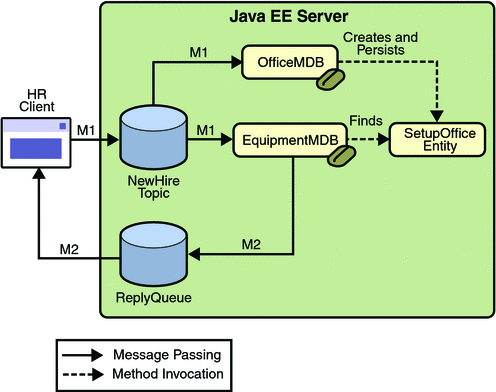Overview of the clientmdbentity Example Application
This application simulates, in a simplified way, the work flow of a company’s human resources (HR) department when it processes a new hire. This application also demonstrates how to use the Java EE platform to accomplish a task that many JMS client applications perform.
A JMS client must often wait for several messages from various sources. It then uses the information in all these messages to assemble a message that it then sends to another destination. The common term for this process is joining messages. Such a task must be transactional, with all the receives and the send as a single transaction. If not all the messages are received successfully, the transaction can be rolled back. For a client example that illustrates this task, see A Local Transaction Example.
A message-driven bean can process only one message at a time in a transaction. To provide the ability to join messages, a Java EE application can have the message-driven bean store the interim information in an entity. The entity can then determine whether all the information has been received; when it has, the entity can report this back to one of the message-driven beans, which then creates and sends the message to the other destination. After it has completed its task, the entity can be removed.
The basic steps of the application are as follows.
-
The HR department’s application client generates an employee ID for each new hire and then publishes a message (M1) containing the new hire’s name, employee ID, and position. The client then creates a temporary queue, ReplyQueue, with a message listener that waits for a reply to the message. (See Creating Temporary Destinations, for more information.)
-
Two message-driven beans process each message: One bean, OfficeMDB, assigns the new hire’s office number, and the other bean, EquipmentMDB, assigns the new hire’s equipment. The first bean to process the message creates and persists an entity named SetupOffice, then calls a business method of the entity to store the information it has generated. The second bean locates the existing entity and calls another business method to add its information.
-
When both the office and the equipment have been assigned, the entity business method returns a value of true to the message-driven bean that called the method. The message-driven bean then sends to the reply queue a message (M2) describing the assignments. Then it removes the entity. The application client’s message listener retrieves the information.
Figure 32–2 illustrates the structure of this application. Of course, an actual HR application would have more components; other beans could set up payroll and benefits records, schedule orientation, and so on.
Figure 32–2 assumes that OfficeMDB is the first message-driven bean to consume the message from the client. OfficeMDB then creates and persists the SetupOffice entity and stores the office information. EquipmentMDB then finds the entity, stores the equipment information, and learns that the entity has completed its work. EquipmentMDB then sends the message to the reply queue and removes the entity.
Figure 32–2 A Java EE Application: Client to Message-Driven Beans to Entity

- © 2010, Oracle Corporation and/or its affiliates
